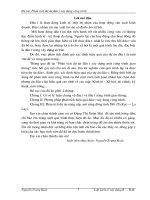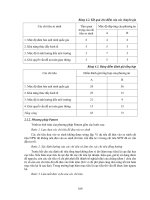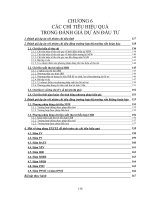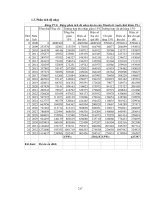Phân tích giả lập đầu tư các tập đoàn công nghệ Hoa Kỳ Tiếng anh 8đ
Bạn đang xem bản rút gọn của tài liệu. Xem và tải ngay bản đầy đủ của tài liệu tại đây (213.66 KB, 12 trang )
In the past 5 years, the US stock market has experienced remarkable growth, with
several notable milestones, including:
From 2016 to 2021, the S&P 500 index increased from around 2,200 points to over
4,300 points, equivalent to a growth rate of over 95%.
The highest point of the Dow Jones Industrial Average index also increased from
around 18,000 points at the beginning of 2016 to over 35,000 points at the
beginning of 2021.
The US stock market experienced a brief downturn at the beginning of 2018 and a
sharp decline in March 2020 due to the impact of the COVID-19 pandemic, but
quickly recovered strongly thereafter.
Consumer goods, technology, and healthcare industries have become the leading
stock groups in the US stock market in recent years, contributing significantly to
market growth.
Overall, the US stock market has experienced impressive growth and overcome
obstacles to recover quickly over the past 5 years. Consumer goods, technology,
and healthcare industries have played a leading role in this development.
Year Dow Jones
S&P 500
Growth rate compared to the previous year
2018 23,327.46
2,506.85
-5.6%
2019 28,538.44
3,230.78
28.9%
2020 30,606.48
3,756.07
16.3%
2021 35,326.26
4,461.47
18.7%
2022 36,738.24
4,841.28
8.5%
In general, the situation of the two stock exchanges in the United States has seen
remarkable growth during the period of 2019-2022, with impressive increases
recorded, particularly almost 30% in 2019, even during the midst of the COVID-19
pandemic.
year
stock
price
Growth rate compared to the previous yea
2022 Apple
178.55
38.8%
2022 Alphabet
2,320.24
63.7%
2022 Amazon
3,901.83
40.7%
2022 Facebook
348.48
35.5%
2022 Microsoft
371.11
32.4%
2022 Nvidia
341.87
46.5%
2022 PayPal
250.15
27.4%
2022 Square
205.60
45.5%
2022 Tesla
1,125.15
55.8%
2022 Zoom
181.11
16.3%
As can be seen, based on statistics collected from Yahoo Finance, the technology
stock group is the top spearhead of the US stock market in 2022. Especially, large
corporations such as Apple, Amazon, Tesla, and Alphabet have recorded extremely
impressive growth rates, with Alphabet achieving a positive growth rate of 63.7%.
The potential of the US stock market in the coming years is still subject to many
influencing factors, but many experts predict that the market will continue to
develop and grow in the near future. Here are some reasons for this positive
assessment:
The growth momentum of the US stock market in recent years has been supported
by some macroeconomic factors, such as GDP growth, low unemployment rates,
low interest rates, and government support.
The monetary policies of the US Federal Reserve (Fed) and governments are also
being implemented to keep the economy stable and recover from the COVID-19
pandemic, which could create a favorable environment for the stock market.
Consumer goods, technology, and healthcare industries are still continuing to
develop and have potential for growth in the future. In addition, other industries
such as renewable energy, air quality, and clean water are also expected to have
potential for growth in the future.”
Price history:
Criterion
AAPL
ABBV
AL
RYT
SFM
SQLV
VUG
UCO
2020
132.69
107.15
44.42
253.55
20.10
29.48
253.34
9.07
2021
177.57
135.40
44.23
324.03
29.68
39.96
320.90
21.69
2022
129.93
161.61
38.42
242.98
32.62
34.39
213.70
30.31
2023 (May)
173.5
148.03
37.84
259.08
36.42
34.07
252.09
23.50
AAPL
Revenue and Profit Growth: Apple has achieved impressive revenue and profit
growth in recent years, thanks to popular products such as the iPhone, iPad,
MacBook, and services such as the App Store and Apple Music. In the fiscal year
ending in December 2022, Apple's revenue reached $117.154 billion, an increase
of 30% from the previous quarter. Similarly, the company's net profit also
increased by over 30% in this fiscal quarter, reaching $50.332 billion. In just the
first quarter of 2023, revenue has already reached over 80% of the revenue for the
fiscal year ending 2022, demonstrating a fairly impressive revenue growth rate.
Stock Valuation: Apple's stock price is currently around $173 (as of May 2023),
with a total market capitalization of about $2.2 trillion. Compared to other
technology companies such as Amazon or Microsoft, Apple has a lower price-toearnings (P/E) ratio, hovering around 28.
Market Position and Competitors: Apple is one of the largest technology
companies in the world, with a large global market share of the iPhone and iPad.
However, the company is also facing fierce competition from rivals such as
Samsung, Google, and Huawei.
Future potential: Apple is investing heavily in new areas such as healthcare and
self-driving cars, while also continuing to improve and upgrade existing products.
Additionally, Apple is increasing its manufacturing operations in the United States
and seeking ways to minimize the impact of the US-China trade war.
The overall ESG risk score is 17% and ranks 15th, indicating that the company is
facing some environmental, social, and governance risks. However, the overall risk
score of the company is relatively low, which is a positive point.
The environmental risk score of the company is 0.6, which is quite low and
indicates that the company is managing environmental issues well.
The social risk score of the company is 6.9, which is relatively high and indicates
that the company needs to improve its management of social issues, including
human resources management, customer and community relations, supply chain
management, etc.
The governance risk score of the company is 9.2, which is also relatively high and
indicates that the company needs to improve its organizational management,
including financial management, risk management, compliance with regulations,
etc.
ABBV
Revenue: In the fiscal year ending on December 30, 2022, ABBV recorded
revenue of $58,054,000, an increase of approximately 4% compared to the
previous year.
Profit: In the fiscal year 2021, ABBV achieved a net profit of $40,640,000, an
increase of 5% compared to the previous year.
Cash flow: ABBV had positive free cash flow of $24,943,000 in fiscal year 2022.
Total assets: ABBV's total assets at the end of fiscal year 2022 reached
$138,805,000.
Total debt: ABBV's total debt at the end of fiscal year 2022 was $131,093,000.
An overall view of ABBV's financial situation shows that the company has both
growing revenue and profits, positive free cash flow, and a sufficiently large total
asset base. However, ABBV has a significant amount of debt.
Growth potential:
Growth plan: ABBV is implementing a growth plan by expanding research and
development of new products, expanding its market and strengthening its
competitive abilities.
Competitive capacity: ABBV is one of the leading companies in the
pharmaceutical industry, with a diverse product portfolio and a continuous
development of new products.
Market opportunities: The pharmaceutical industry has high growth potential due
to increasing demand for drugs from countries around the world.
Field of operation of the company:
ABBV operates primarily in the pharmaceutical sector and is divided into two
main segments: Immunology and Oncology. ABBV's products mainly focus on the
pharmaceutical field with key products such as Humira, Imbruvica, and Venclexta.
This is a highly competitive and challenging market, but also has high growth
potential due to the increasing demand for healthcare.
The current P/E ratio is around 9.3, lower than the industry average of 13.8. This
suggests that ABBV is currently undervalued compared to its competitors in the
industry. Looking at the stock price, it can be seen that ABBV is currently trading
at its lowest level in the past 52 weeks, which may indicate some underlying risks
for this stock.
The social risk score is 16.9 out of a total of 28 ESG risk scores, indicating that the
company's social risk is still relatively high. Social risk scores are often related to
the company's activities that affect relationships with stakeholders, including
employees, customers, communities, and investors. Factors that may contribute to
social risks include violations of labor regulations, occupational safety, product
quality, resource and environmental use, and contributing to social issues such as
corruption, racial discrimination, and so on. Therefore, the company needs to focus
on managing and minimizing social risks in its business operations.
In the current quarter (June 2023), the estimated average income of 13 analysts is
$2.6 per share. In the next quarter (September 2023), the estimated average income
of 13 analysts is $2.52 per share. In 2023, the estimated average income of 18
analysts is $9.76 per share, with a low estimate of $9.48 and a high estimate of
$10.06. In 2024, the estimated average income of 19 analysts is $9.85 per share,
with a low estimate of $8.44 and a high estimate of $11.01. The EPS of the
previous year (2022) was $3.37 per share.
From this estimated table, it can be seen that analysts predict an increase in the
company's income in the future, with estimated average incomes of 2023 and 2024
being higher than the EPS of the previous year. However, in 2024, the lowest
estimated income is only $8.44 per share, lower than the lowest estimated income
of 2023 ($9.48 per share). This indicates that the company's future still has many
risk factors and needs further monitoring and evaluation.
Based on the revenue estimate table, it can be seen that the company's revenue is
predicted to decrease in the future. In 2023, the estimated revenue is $46.87 billion,
a 19.3% decrease from the previous year's revenue. Meanwhile, the estimated
revenue for 2024 also slightly decreased by 0.4% compared to the estimated
revenue for 2023.
AL
The total revenue for the fiscal year 2022 reached 2,317,302 USD, an increase
of about 10% compared to the previous year. Gross profit reached 858,423
USD, a 15% increase compared to the same period in 2021. Operating cash
flow still remained positive, albeit with an insignificant increase, recording a
figure of 1,382,150 USD, but free cash flow has been negative continuously for
4 years from 2019 to 2022, which poses some risks such as:
Financial risk: The company may not have enough funds to pay debts or
other obligations such as salaries, taxes, fees, and other operating
expenses.
Stock devaluation: If investors believe that the company cannot repay
debts or develop its business, they may sell the company's stock and
reduce its value.
Reduced motivation for investors: Investors may not want to invest in a
company with negative free cash flow due to financial risks and reduced
motivation for the company to develop and expand its business.
Limited growth potential: If the company does not have enough funds to
invest in research and development or expand its operations, the
company's growth potential will be limited.
RYT
The company's stock price is average within the 52-week range.
The company's net assets are $2.49B, indicating good financial capability.
The company's PE ratio is 23.50, indicating that the company's stock price is
relatively high compared to its profits.
The YTD total daily profit of the company is 6.81%, indicating that the
company has achieved good results this year.
The company's beta is 1.24, indicating that the company has a moderate
market risk.
The company's (net) expense ratio is 0.40%, indicating that the company has
good cost management capabilities.
Without access to the company's financial information, it is difficult to evaluate
its growth potential and necessary level of risk. However, looking at the
overallperformance, it is still showing a positive figure of nearly 7% per day.
But there is still not enough basis to make an investment decision => Remove.
SFM
Overview of key metrics:
The market capitalization of the company is 3.697 trillion USD, which is
relatively large compared to other companies in the industry.
The company's P/E ratio (TTM) is 16.02, indicating that the stock price is
priced at an average level compared to other companies in the industry.
The company's EPS (TTM) is 2.24, indicating that the company has
profit per share.
The average trading volume of the company is 1,651,176, which is
relatively high liquidity.
The company's 52-week range is from 22.56 to 39.99 USD, indicating
that the stock price has increased to a higher level recently.
Overall, Sprouts Farmers Market, Inc. has a large market capitalization, is
priced at an average level, has profit per share, and relatively high liquidity.
Financial health status:
Total assets and liabilities: The total assets of Sprouts Farmers
Market, Inc. is 3.070.380 USD in the fiscal year 2022, of which the
liabilities to be paid is about 2.023.918 USD.
Revenue and profit: Sprouts Farmers Market, Inc.'s revenue increased
from 5.2 billion USD in 2016 to 6.5 billion USD in 2022. However,
the company's profits in recent years have been unstable, reaching a
peak in 2016 and sharply declining in 2018 before recovering to a
decent level in 2019 and 2020.
Gross profit and net profit: The company's gross profit has fluctuated
around 25-30% in recent years. The company's net profit has also
fluctuated significantly, from negative in 2018 to positive in 2019 and
2020.
Financial ratios: The company's P/E ratio is about 15.3, and the ROE
is about 21.7%, indicating that the company has a reasonable
valuation and relatively efficient financial operations.
SQLV
Market Overview:
Regarding stock price: The company's stock price is currently trading at a
low range within the past 52 weeks, and there has been no significant
fluctuation in the recent trading session.
Regarding finance: The company has a relatively low net asset value of
only 24.28 million USD, however, the NAV is relatively high, reaching
34.17 USD. The P/E ratio (TTM) is at a low level, only about 6.00, while
the relative yield is stable, reaching 1.32%. However, YTD total daily
profit is at a low negative level.
Regarding market volatility: The company's beta is 0.97, indicating that
the volatility of this stock is quite relative to the overall market.
Regarding business history: The company was established in 2017, so its
business history is still quite short.
Similar to RYT, there is no access to information about the company's financial
status and financial reports, so it is not sufficient to make investment decisions.
However, the company's recent investment performance is evaluated to be
relatively low, maintaining a figure of around -1%. The risk level is also
indicated in the warning state.
=> Remove this stock.
VUG
Market Overview:
Regarding stock price: The company's stock price is currently trading at a
low range within 52 weeks and there has not been significant volatility in
the recent trading session.
Regarding finance: The company has relatively low net assets at only
24.28 million USD, but the NAV is quite high at 34.17 USD. The P/E
ratio (TTM) is low at around 6.00 and the productivity is relatively stable
at 1.32%. However, YTD total daily profit is in a low negative level.
Regarding market volatility: The company's beta is 0.97, indicating a
relatively high degree of stock volatility compared to the general market.
Regarding business history: The company was established in 2017, so the
company's business history is still relatively short.
Similar to RYT, it is not possible to access information on the company's
financial situation and financial reports, so there is not enough basis to make
investment decisions.
However, the company's recent investment performance has been evaluated
quite low, maintaining a figure of approximately -1%. The level of risk is also
reflected in the alert status.
=> Remove this stock.
UCO
Overall market evaluation:
ProShares Ultra Bloomberg Crude Oil (UCO) is an ETF (Exchange Traded
Fund) designed to track the inverse performance of crude oil futures. The
company focuses on investing in crude oil futures contracts and uses leverage to
increase returns.
There is no information on the P/E ratio for this company. The yield is also 0%,
and YTD total daily return is at -22.47%, indicating a high level of risk in
investing in this company. The expense ratio (net) is 0.95%, higher than many
other ETF funds. The company's beta is 2.76, indicating a higher volatility
compared to the overall market.
On the other hand, there are significant fluctuations in the oil and gas industry
due to tensions from the Russia-Ukraine conflict.
Therefore, investing in this company carries more risks => Remove.
Summary: The stocks worth investing in are (AAPL, ABBV, SFM)
Based on the analysis and current growth potential of the companies, we
recommend allocating $100,000 with the following weights:
Capitalization
ratio/stock
100%
AAPL
ABBV
SFM
50%
30%
205









